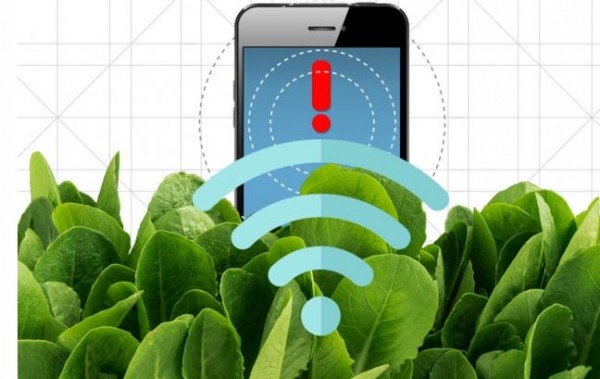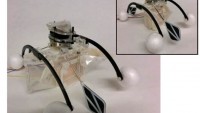MIT Scientists Enable Spinach Plants to Detect Explosives
| Arthur Dominic Villasanta | | Oct 31, 2016 09:34 PM EDT |
(Photo : Christine Daniloff/MIT) MIT engineers have transformed spinach plants into sensors that can detect explosives and wirelessly relay that information to a handheld device.
Spinach isn't only healthy, but MIT engineers have engineered it so it can save lives by detecting explosives. It's a knockout iteration of Popeye's favorite food.
By embedding leaves with carbon nanotubes, MIT engineers have transformed spinach plants into sensors that can detect explosives and wirelessly relay that information to a handheld device such as a smartphone.
Like Us on Facebook
This is one of the first demonstrations of engineering electronic systems into plants, an approach that the researchers call "plant nanobionics."
"The goal of plant nanobionics is to introduce nanoparticles into the plant to give it non-native functions," said Michael Strano, the Carbon P. Dubbs Professor of Chemical Engineering at MIT and the leader of the research team.
The spinach plants were designed to detect chemical compounds known as nitroaromatics, which are often used in landmines and other explosives.
When one of these chemicals is present in the groundwater sampled naturally by the plant, carbon nanotubes embedded in the plant leaves emit a fluorescent signal that can be read with an infrared camera. The camera can be attached to a small computer similar to a smartphone, which then sends an email to the user.
"This is a novel demonstration of how we have overcome the plant/human communication barrier," said Strano, who believes plant power could also be harnessed to warn of pollutants and environmental conditions such as drought.
Strano is the senior author of a paper describing the nanobionic plants in the Oct. 31 issue of Nature Materials. The paper's lead authors are Min Hao Wong, an MIT graduate student who has started a company called Plantea to further develop this technology, and Juan Pablo Giraldo, a former MIT postdoc who is now an assistant professor at the University of California at Riverside.
Plants are ideally suited for monitoring the environment because they already take in a lot of information from their surroundings, according to Strano.
"Plants are very good analytical chemists. They have an extensive root network in the soil, are constantly sampling groundwater, and have a way to self-power the transport of that water up into the leaves."
In the new study, the researchers embedded sensors for nitroaromatic compounds into the leaves of spinach plants. Using a technique called vascular infusion, which involves applying a solution of nanoparticles to the underside of the leaf, they placed the sensors into a leaf layer known as the mesophyll, which is where most photosynthesis takes place.
They also embedded carbon nanotubes that emit a constant fluorescent signal that serves as a reference. This allows the researchers to compare the two fluorescent signals, making it easier to determine if the explosive sensor has detected anything. If there are any explosive molecules in the groundwater, it takes about 10 minutes for the plant to draw them up into the leaves, where they encounter the detector.
Tagsspinach, MIT, Explosives, Nanotubes, plant nanobionics, nitroaromatics, Michael Strano
©2015 Chinatopix All rights reserved. Do not reproduce without permission
EDITOR'S PICKS
-

Did the Trump administration just announce plans for a trade war with ‘hostile’ China and Russia?
-

US Senate passes Taiwan travel bill slammed by China
-

As Yan Sihong’s family grieves, here are other Chinese students who went missing abroad. Some have never been found
-

Beijing blasts Western critics who ‘smear China’ with the term sharp power
-

China Envoy Seeks to Defuse Tensions With U.S. as a Trade War Brews
-

Singapore's Deputy PM Provides Bitcoin Vote of Confidence Amid China's Blanket Bans
-

China warns investors over risks in overseas virtual currency trading
-

Chinese government most trustworthy: survey
-

Kashima Antlers On Course For Back-To-Back Titles
MOST POPULAR
LATEST NEWS
Zhou Yongkang: China's Former Security Chief Sentenced to Life in Prison

China's former Chief of the Ministry of Public Security, Zhou Yongkang, has been given a life sentence after he was found guilty of abusing his office, bribery and deliberately ... Full Article
TRENDING STORY

China Pork Prices Expected to Stabilize As The Supplies Recover

Elephone P9000 Smartphone is now on Sale on Amazon India

There's a Big Chance Cliffhangers Won't Still Be Resolved When Grey's Anatomy Season 13 Returns

Supreme Court Ruled on Samsung vs Apple Dispute for Patent Infringement

Microsoft Surface Pro 5 Rumors and Release Date: What is the Latest?














